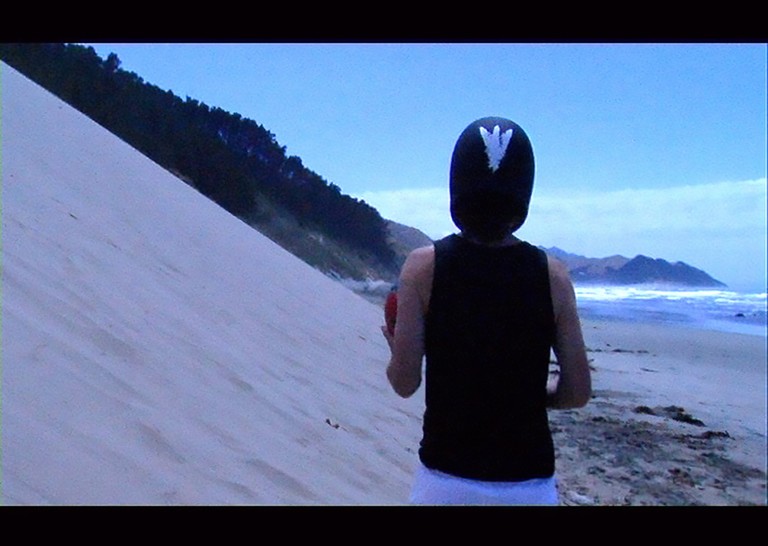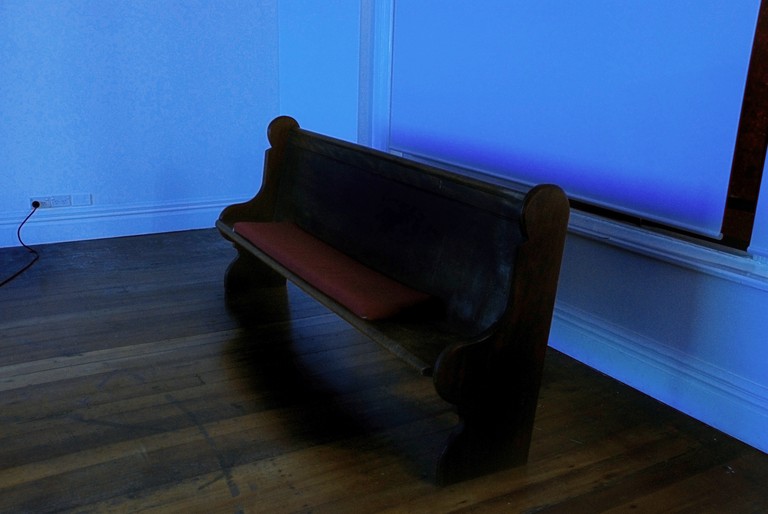Exhibition Essays
Gospel
April 2008
Peace May Reign
Bronwyn Holloway-Smith

-1-
"On the morning of Nov 5, 1881, 644 armed constabulary and 945 volunteers attacked [Parihaka]. They were greeted by children singing. Te Whiti and Tohu were arrested, their people offering no resistance. Over the following weeks, the 1500 visitors who had been drawn to Pari haka were dispersed and the buildings and farmland largely destroyed".FTN1
Almost 126 years following the tragic invasion and destruction of Parihaka, and 100 years following the death of Te Whiti-o-Rongomai, Murray Hewitt and I arrive at the remarkable site of passive resistance. We are surprised by the quiet unassuming settlement: there are no information boards with grainy black and white historical images of the site, not even a modest yellow road sign declaring it a place of historical importance. It takes us a few minutes to decide that we have, in fact, arrived at the right place.
Hewitt has arranged to meet one of the leaders from Parihaka pa, Wharehoka Wano, at the pa's wharenui to ask for permission to use the Raukura symbol in an artwork. I am here to support him. The Raukura is a legacy left for all people by the Prophets Te Whiti-o-Rongomai and Tohu Kakahi of Parihaka and conveys a message of peace and goodwill, symbolised by three white albatross feathers.FTN2
-2-
Few people outside Taranaki knew the story of Parihaka when Dick Scott's second book on the subject Ask That Mountain: The Story of Parihaka was published in 1975. As Scott's first book about Parihaka The Parihaka Story (1954) was written with little Maori input, he had been working on improving it. Assisted by the late Parihaka elder Whatarau Wharehoka, Scott reworked the story and Ask That Mountain was published in 1975.FTN3 The book received positive attention from almost every newspaper in the country, awakening middle New Zealand to what had happened there, and to the enormous grief of the people of Parihaka. As Scott concerned himself with the literasy retelling of Parihaka's history, many artists and asts institutions were simultaneously concerning themselves with cementing Parihaka's story in New Zealand's art history. In 1973, a groundbreaking exhibition about Te Whiti took place at the Waikato Art Museum.FTN4 In 1981, the Parihaka Centennial Exhibition & Art Auction took place at the Govett-Brewster Art Gallery. Then, in 2000, the major exhibition Parihaka: The Art of Passive Resistance at City Gallery Wellington drew from and expanded on these previous exhibitions.
One key work in The Art of Passive Resistance was a painting by Michael Smither depicting three idyllic white albatross feathers, representing the Raukura, hovering over the silhouette of Mount Taranaki at sunset. This image has become well recognised due to its widespread reproduction and distribution as the cover design of Ask That Mountain. It is this specific depiction of the Raukura that Hewitt wished to incorporate into his artwork.

-3-
Following our welcome on to the wharenui and a few minutes of friendly conversation, our hosts ask the reason for our visit. Hewitt explains that he wishes to gain permission from the tribe to create a video art work featuring the Raukura feathers displayed on the back of a 1970s motorcycle crash helmet.FTN5 Smither, who donated the painting to the tribe as the rightful owners ofthe emblem, had referred Hewitt to Te Ati Awa.
The elders discuss the matter in te reo. Neither Hewitt nor are I are fluent speakers of the language so the discussion is a mystery to us. We sense, however, that there is an issue that they are trying to resolve. After a few minutes an elder explains that they are grateful for the respect that Hewitt has shown by asking for permission for use ofthe emblem, however the Raukura is a major item of taonga to Te Ati Awa. It has been used in the past without permission and, in some situations, the symbol's meaning has been abused. The tribe wishes to keep the meaning of the emblem as pure to its original intention as possible, and to be able to do that they must control when and how it is used. They explain that it is a brand identity for the tribe, as well as carrying deeper spiritual and historical meaning. With those considerations, the representatives commend Hewitt for the process he undertook in seeking to use the emblem and are happy for him to use it on the condition that he gains permission from the other two hapu that make up Te Ati Awa, as Te Whiti gifted the Raukura to all of Te Ati Awa as a tribe.
The meeting progresses over the nest two hours as more groups of people arrive at the wharenui. Each time the arriving group is brought up to speed with the discussion, and Hewitt repeats his request. Following this initial meeting, Hewitt returns to Parihaka twice more meeting with members of the other hapu who co-own the Raukura. He finally gains permission and is able to make his work.
-4-
Weeping Waters, the English translation of Waitangi, was one of four video works featured in Hewitt's Enjoy exhibition Gospel. Set in a rugged-yet-scenic coastal New Zealand environment it depicts a solitary man wearing a crash helmet bearing the Raukura emblem. The man begins kicking a football as far as possible up the slope of a large sand dune. As gravity repeatedly brings the ball back down, he sends it back up. The work repeats in this fashion over ten minutes, becoming an act of endurance for the performer and suggesting that the activity is doomed to be a constant struggle.
Weeping Waters was first shown as part of Hewitt's end-of-year studies exhibition for his Masters degree, a one-night installation at Central Baptist Church, Wellington. The installation was open to the public for one and a half hours and was, partly due to the site, a very powerful experience. Viewing the works in the charged atmosphere of a Christian Church raised issues of spirituality, patriotism, and slavery that did not translate so readily to the environment of Enjoy gallery space.FTN6 As an attempt to transfer some of this atmosphere to Enjoy, an organ and single church pew were installed as part of Gospel, however rather than implying a church-like environment, these objects heightened aspects of isolation, depression, and loneliness within the video works.
This sense of isolation within the New Zealand landscape locates Weeping Waters in the context of John Mulgan's novel Man Alone.This archetypal myth of the New Zealand man, an outsider in bis own land and alone in the world, has been discussed directly in relation to McCahon, among others, and is quite apparent in Weeping Waters. Hewitt's helmeted solitary protagonist is a recurring character within Hewitt's oeuvre, having previously been seen in the provocative work Burnings (2005) in the guise of a Ku Klux Klan member burning rugby posts, and also in the Gospel exhibition in Untitled (2007), shooting a car. In Weeping Waters, he takes on the persona of the troubled bachelor somewhat piously attempting to deal with complex issues of New Zealand's bi-cultural tension through his ball-kicking skills.
Once again, however, the man alone is exposed as a myth, for Weeping Waters is Hewitt's reaction to the New Zealand Government's Seabed and Foreshore legislation of 2006- legislation that was marked by a staggering turnout for a country-length protest hikoi to Wellington. He is certainly not a man alone in his reaction to this issue. By referencing Parihaka he is suggesting that although the Government has acknowledged its wrongdoing in the historical process of taking land from the Maori, it is merely paying lip-service to the fact while deviously repeating the process.FTN7 The futile act of kicking a ball up a hill has the dual function of both an attempted anger therapy exercise and a metaphorical suggestion that progress towards resolving historical injustice may seem like an ongoing struggle.

However, there is a positive message in Weeping Waters. Hewitt, to his credit, followed the process of obtaining permission to use the Raukura through to completion, reminding us that perseverance can still result in success. In the end, he gained rightful use of the symbol and he was able to make Weeping Waters with the support of the people of Parihaka. If Hewitt's respect and understanding for the Maori people is taken as an example, it provides hope that with more attitudes like his, New Zealand may one day be able to kick the metaphorical ball of historical grievances over the hill.
-
1.
Simon Garrett, "Telling the Story of Parihaka", The Lancet 356, issue 9245 (2000): 1935-1936.
-
2.
The Raukura conveys the following message:
Kororia ki te Atua I runga rawa (Glory to God on high)
Maungarongo ki runga I te whenua (Peace on earth)
Whakaaro pai ki nga tangata katoa (Godwill to all mankind)See: "Raukura", Te Ati Awa website, http://www.atiawa.com/raukura, (accessed May 25, 2008).
This message echoes the biblical story of a choir of angels that appear to shepherds upon the birth of Jesus Christ, see: Luke, "Luke", in Good News Bible, God, et al. (United States of America: American Bible Society, 1976), 2:14.
-
3.
Virginia Winder, "Taranaki Stories: Confilct and Protest- Dick Scott outlines own Parihaka journey", Puke Ariki, http://www.pukeariki.com/en/stories/conflict/dickscott.htm (accessed May 22, 2008).
-
4.
"Taranaki Saw it All: The Story of Te Whiti O Rongomai of Parihaka", conceived and curated by James Mack for the Waikato Art Museum in 1973. See Peter Simpson, "Parihaka: A Very Real Symbol", Art New Zealand, 97, (2000): 54-59, 98-99
-
5.
Hewitt has used the crash helmet in previous works as a symbol for passive resistance tn New Zealand, particularly relating to the Springbok Tour protests of 1981. See Murray Hewitt Burnings (2005) digital video 002:27 (looped)
-
6.
A popular film recounting the story of William Wilberforce, Amazing Grace, was screening in Wellington around this time resulting an atmosphere of cultural discussion about issues of historic and current slavery. The song Amazing Grace was also played by a live organist for the duration of the Central Baptist installation, and at the opening of Gospel.
-
7.
The United Nations Special Rapporteur report of 2006 recommended that the Seabed and Foreshore Legislation should be repealed or significantly amended. See http://www.converge.org.nz/wiki/smzmarch06.pdf (accessed 12 July 2008).
See also http://en.wikipedia.org/wiki/New_Zealand_foreshore_and_seabed_controversy (accessed 30 June 2008).
